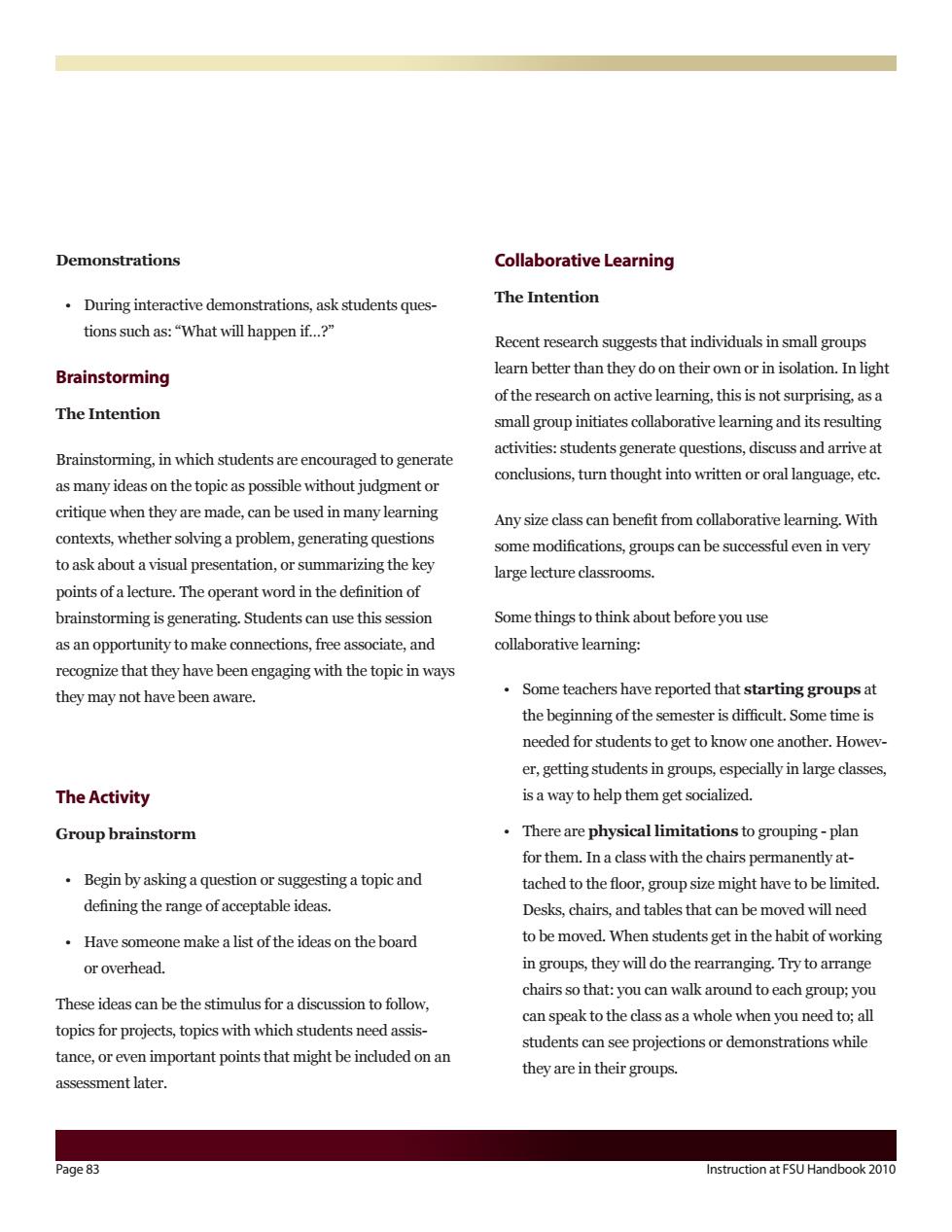正在加载图片...

Demonstrations Collaborative Learning .During interactive demonstrations,ask students ques- The Intention tions such as:"What will happen if. Recent research suggests that individuals in small groups Brainstorming learn better than they do on their own or in isolation.In light of the research on active learning,this is not surprising,asa The Intention small group initiates collaborative learning and its resulting activities:students generate questions,discuss and arrive at Brainstorming,in which students are encouraged to generate as many ideas on the topic as possible without judgment or conclusions,turn thought into written or oral language,etc. critique when they are made.can be used in many learning Any size class can benefit from collaborative learning.With contexts,whether solving a problem,generating questions some modifications,groups can be successful even in very to ask about a visual presentation,or summarizing the kev large lecture classrooms points of a lecture.The operant word in the definition of brainstorming is generating.Students can use this session Some things to think about before you use as an opportunity to make conections,free associate,and collaborative learning: recognize that they have been engaging with the topic in ways they may not have been aware Some teachers have reported that starting groups at the beginning of the semester is difficult.Some time is needed for students to get to know one another.Howev. er,getting students in groups,especially in large classes The Activity is a way to help them get socialized. Group brainstorm There are physical limitations to grouping-plan for them.In a class with the chairs permanently at- .Begin by asking a question or suggesting a topic and tached to the floor,group size might have to be limited. defining the range of acceptable ideas Desks,chairs,and tables that can be moved will need Have someone make a list of the ideas on the board to be moved.When students get in the habit of working or overhead. in groups,they will do the rearranging.Try to arrange chairs so that:you can walk around toeach group:yo These ideas can be the stimulus for a discussion to follow can speak to the class as a whole when you need to;all topics for projects,topics with which students need assis students can see projectionsor demonstrations while tance,or even important points that might be included on an they are in their groups. assessment later. ge 8 nstruction at FSU Hand Page 83 Instruction at FSU Handbook 2010 Demonstrations • During interactive demonstrations, ask students questions such as: “What will happen if…?” Brainstorming The Intention Brainstorming, in which students are encouraged to generate as many ideas on the topic as possible without judgment or critique when they are made, can be used in many learning contexts, whether solving a problem, generating questions to ask about a visual presentation, or summarizing the key points of a lecture. The operant word in the definition of brainstorming is generating. Students can use this session as an opportunity to make connections, free associate, and recognize that they have been engaging with the topic in ways they may not have been aware. The Activity Group brainstorm • Begin by asking a question or suggesting a topic and defining the range of acceptable ideas. • Have someone make a list of the ideas on the board or overhead. These ideas can be the stimulus for a discussion to follow, topics for projects, topics with which students need assistance, or even important points that might be included on an assessment later. Collaborative Learning The Intention Recent research suggests that individuals in small groups learn better than they do on their own or in isolation. In light of the research on active learning, this is not surprising, as a small group initiates collaborative learning and its resulting activities: students generate questions, discuss and arrive at conclusions, turn thought into written or oral language, etc. Any size class can benefit from collaborative learning. With some modifications, groups can be successful even in very large lecture classrooms. Some things to think about before you use collaborative learning: • Some teachers have reported that starting groups at the beginning of the semester is difficult. Some time is needed for students to get to know one another. However, getting students in groups, especially in large classes, is a way to help them get socialized. • There are physical limitations to grouping - plan for them. In a class with the chairs permanently attached to the floor, group size might have to be limited. Desks, chairs, and tables that can be moved will need to be moved. When students get in the habit of working in groups, they will do the rearranging. Try to arrange chairs so that: you can walk around to each group; you can speak to the class as a whole when you need to; all students can see projections or demonstrations while they are in their groups